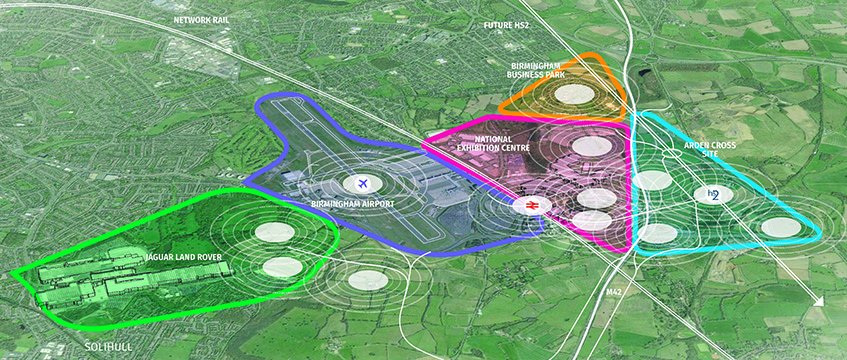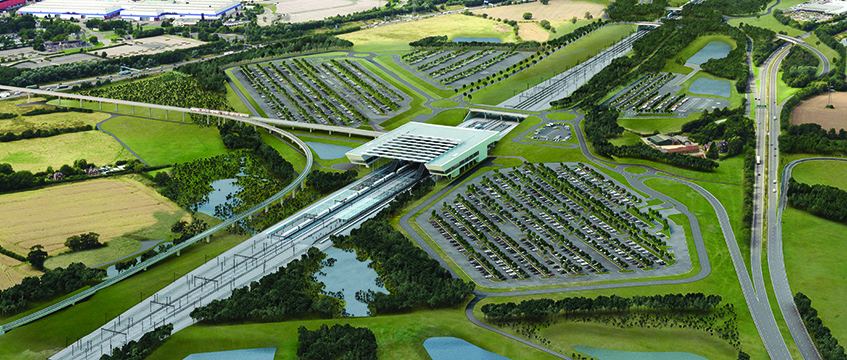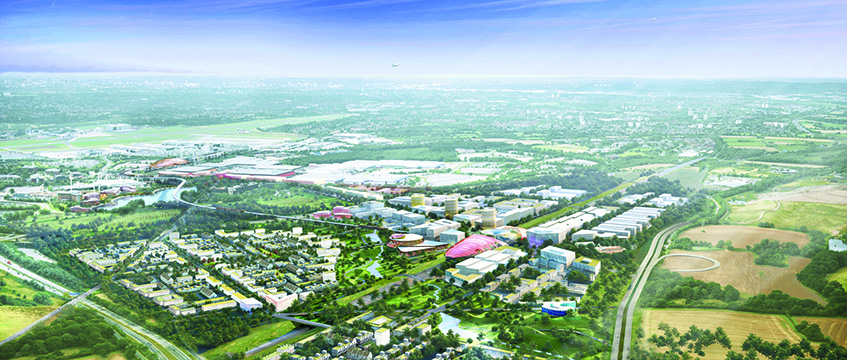The organisation responsible for the new HS2 station in Solihull, on the outskirts of Birmingham, has formally applied to government to expand the design in a move intended to unlock thousands of acres of development land around the new terminus.
Urban Growth Company’s application for UK Central, the interchange next to Birmingham Airport, will be watched closely by other stations – including Birmingham Curzon Street and London Euston – to see how the government works with authorities as they look to bring forward their own enormous projects.
UGC is also set to release masterplanning framework documents in September that will finally allocate land around the station for development.
Its initial Growth and Infrastructure Plan, released in March, said the 3,000-acre site had space for 8.3m sq ft of commercial development and up to 4,000 homes, with a development value of £4.1bn.
Critically, the new plans are expected to put an end to the construction of a new terminal for the airport above the station, allowing development on the 350-acre Ardent Cross site within the plan and closest to the station.
This means landowners there will be able to commence the hunt for a development partner for up to 2,000 homes and 2.7m sq ft of commercial space.
The landowners
The NEC, Jaguar Land Rover, Birmingham Airport and Arden Cross – which owns the land around the proposed new HS2 station – all have competing interests surrounding the development of the interchange.

Increasing passenger numbers at the airport, to the west of the site, mean it will soon reach its estimated capacity of 30m passengers a year.
Its current site does not easily allow expansion, and the airport has been consulting on a number of options for its future growth.
One of these was the development of a new terminal above the HS2 interchange station, which would free up more airport space for taxiing. The problem was that this would scupper most of the plans for Arden Cross.
David Winstanley, chief operating officer for Birmingham Airport, says it will be consulting on options later this year.
“Birmingham Airport is currently undergoing a masterplanning process to explore and preserve options for the long term future of Midlands air rail,” he says. “This exercise is not only looking at plans to develop its existing site, but also future expansion opportunities and how it makes the most of this unique position with HS2.”
The Arden Cross triangle
The second major landholder is on the site of the actual HS2 line. It is owned by four parties – Solihull Council, Coleshill Estates, Birmingham City Council and Packington Estate.
The triangular site has massive regeneration potential, and Arden Cross is being set up as a company, with Ben Gray as director, to lead the project. The aim is to create a mixed-use, commercial , retail, leisure, light industrial and residential destination.
Soft testing has already been done by GVA, and developers are being consulted with the intention of launching a formal hunt for a partner to help draw up a masterplan and jointly bring forward the site.
However, none of this can be finalised or consulted on until UGC reveals its wider framework intentions and its plans for the station itself.
Urban Growth Company
UGC was set up in 2016 by Solihull Council to coordinate the interests surrounding the new station.
While technically it could not force various landholders to do anything, it could encourage agreement through the provision of infrastructure and planning recommendations to the council.
The objective was to ensure the new station and its infrastructure were leveraged for growth and development.
Missed opportunities – such as Ashford, Kent, which was broadly seen as underdeveloped in the wake of HS1 – were looked at as case studies.
Avoiding conflict of ownership and vision, and creating a co-ordinated plan to attract investment – not just rely on a new station to blindly draw in investment – will all be critical.
“This is a unique site, and we have been working closely with the DfT, HS1, HS2 and the DCLG about lessons learnt [from Ashford],” says Huw Rhys Lewis, managing director of UGC.

The station
As well as confirming the route of the train line itself, the HS2 Bill passed earlier this year also includes trace or parkway stations.
These are bare bones stations, described as sheds surrounded by car parks, that HS2 will pay to develop.
Authorities that wish to change the design of these stations need to formally ask HS2 to upgrade these plans. They also need to pay for the changes themselves.
UGC’s application to formally upgrade its station plans mean it has submitted changes for a new station that is flexible to future development.
HS2 will come back with a written response on how much it will cost, which UGC will have to agree to, before the architects HS2 appoints in January 2018 are given the go-ahead to design it.

And now?
The masterplan framework documents for the station will be released in the autumn, submitted to the West Midlands Combined Authority for endorsement, and then to Solihull Council, whose local plan it will feed into.
Though plans have not been finalised, it is likely UGC will not allow for a terminal above the station, but could allow for a potential new terminal next to it, on the lower east side of the site, through a 10-year option.
A new runway, which could be built further east, on the other side of the A452, would mean there is potential for a two terminal, two runway solution to the airport’s expansion problems.
“We support the principle of encouraging growth for the airport and the other key businesses in the region, and the airport may have a need for second terminal building. What we don’t want to do is block the opportunity,” says Lewis.
As the airport is still consulting on its own options, UGC is unlikely to include this as a strict allocation.
In the meantime, this will allow Arden Cross to be set up as company, appoint a development partner, create a masterplan and begin construction on site. The option agreement for the airport can be worked into this.
UGC is in the position to decide how it will all work, as the controller of the purse strings and invariably the planning permissions. However, we will have to wait for its consultation on how it intends to capture development value uplift to finance the development to see if it has all the answers.
To send feedback, e-mail alex.peace@egi.co.uk or tweet @egalexpeace or @estatesgazette










